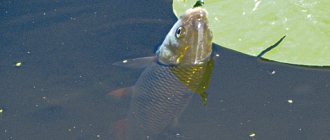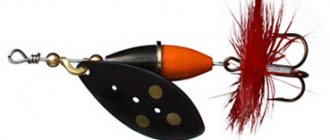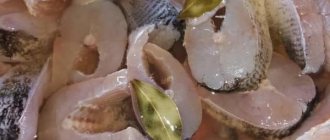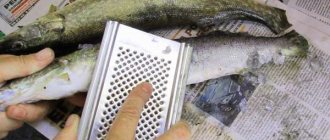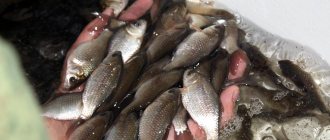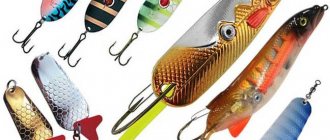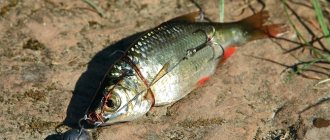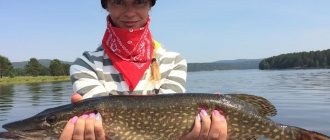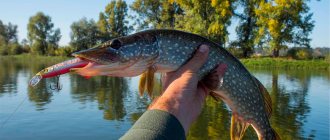Not every fisherman knows that when fishing for pike, you can and should use bait. For what? Of course, to attract the “toothed beauty” and provoke her to bite. Therefore, let’s look at how you can lure pike, properly feed the fishing spot and make this predatory fish bite more actively.
The right bait for pike will ensure a better catch
Popular bait options for pike
Probably every spinning angler is familiar with this situation when you go through all the baits, change fishing spots and experiment with wiring, but nothing in response. Sometimes an hour or two passes, but in the end there is not a single pike bite. Naturally, the question immediately arises: “Why does the “toothy” one ignore any balancer, all kinds of spinners and wobblers? At the same time, you also think about how to get the pike to attack the bait.
One option is to feed the fishing spot. Seems strange? Completely in vain. You can feed not only peaceful fish, but also various predators. Including pike.
Catching it is often much more effective if the fisherman uses bait, which can be a wide variety of options:
- Bloodworm. Including feed - the one that is intended for feeding aquarium fish.
- Maggot. Both red and white. Can be combined with sawdust or sand to create an attractive haze.
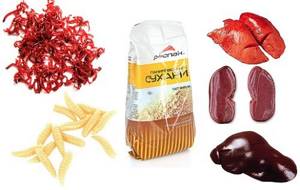
Various products can be used to feed pike - Dry mixtures and homemade do-it-yourself bait in the form of porridge, cereals, dough, bread, etc. Naturally, such food is not of interest to pike. But it attracts “whitefish”, topfin, fry and other small fish, which the “toothy” one hunts for.
- Breadcrumbs. A couple of handfuls of such bait, thrown into the water, attracts various small things, and the pike “catch up” with it.
- Pieces of meat or fish. Pike almost always respond to such feeding. After all, although she loves to chase all sorts of “laundry”, she is unlikely to refuse food in the form of a nutritious piece of meat or fish.
- Pork or beef liver, various offal. They are finely chopped and simply placed in a mesh bag or gauze bag. Then they are thrown into the water. The smell released by the liver (or offal) spreads throughout the water area, attracting pike.
- Combined bait. It includes both cereals and grain, which roaches, rudds, bleaks and other small things rush to, as well as ingredients with blood and flesh. Any predator can sense them in water at a great distance.
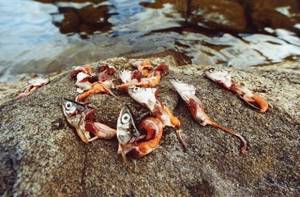
You can feed the pike with pieces of small fish
In fact, there are a lot of options for bait for pike. It’s just that experienced fishermen are in no hurry to give away their secrets. In addition, not everyone attracts a predator at all, relying only on baits. Therefore, even in specialized literature or on the Internet it is difficult to find a good homemade recipe for pike bait. But if you decide to cook it yourself, be sure to use:
- odorous substances;
- protein food (maggots, worms, bloodworms);
- meat and bone meal;
- dry blood;
- pieces of small fish and many others. etc.
Unusual ways to feed pike
Many fishermen also talk about rather exotic methods of luring this freshwater predator, which are used in some regions. Below we will talk about them. If you have a desire, you can try them on your next fishing trip.
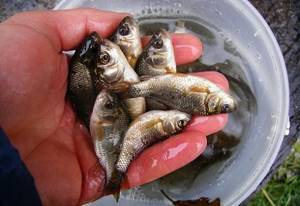
Live bait can be used not only as bait, but also as groundbait
- Live bait (bleak, minnow, gudgeon, roach, etc.) is placed in a glass jar with water. Then it is lowered into the fishing spot. It turns out that the pike sees the fish and tries to attack. But he cannot eat or injure her. By the way, the live bait itself remains in one place and does not swim away anywhere. As a result, the pike simply spins around the can, and with great pleasure takes the bait offered to it in the form of a spinner, wobbler, twister, etc.
- Another unusual option. Live bait is taken. Literally 4-5 fish. Their fins are trimmed. After which they are sent into the water near the place where they catch pike. A wounded fish cannot swim far. However, with its movements, smells and vibrations, it attracts both squinting and larger adults.
Choosing a place to catch pike in the fall
First. The most important commandment is to catch fish where they are. It is useless to throw bait in your own yard, or at a stadium, there are no fish there. Location and location again is the number one factor. There are several possible options for attractive places for successful fishing:
1. Reed border.
We pay attention specifically to the border of the water surface and the walls of vegetation. The pike is an ambush predator, it stands in the very vegetation and carefully guards its territory; nothing disappears from its field of vision, not a tightly packed school of roach, not a lonely fish swimming by. An instant ambush and the victim is caught. For a fisherman, you need to imagine the nature of the behavior of the predator, understand the place of its intended stop, present the bait and wait for a confident grip.
2. Border
other other aquatic vegetation. The algorithm is absolutely similar to the one described above, with the exception of one point, the type of bait used, but more on that later.
3. Coastal edge.
I’m sure many people have heard the expression “it was biting on the shoreline today.” If we decipher it, we get that the fish was biting at a sharp change in depth at some distance from the shore. Why is it convenient for pike to be there, the answer is simple - natural shelter, the fish stands either huddled or at some distance from the shore dump and patrols its surroundings, while remaining unnoticeable to the prey.
4. Underwater anomalies.
Again we must remember that the fish stands and hunts only where it is convenient for it. Not where it is convenient for the fisherman, but specifically for the fish. I repeat that pike is an ambush predator, and the presence of shelter is important for it. An underwater snag, an old sunken boat, a bend in a flooded stream. These places can be detected either with specialized equipment - an echo sounder, or by changes in water flows, but this is a complex and special case. For the most part, fishermen actively use technology and rely on acquired experience.
Bait for pike in summer
Let's start with fishing in the warmest time of the year. Naturally, it's summer. During this period, pike are quite active. But at the same time, there are often days when it is difficult to interest her even with the most attractive and working bait. Bait containing blood particles or chopped fish should help. Such bait emits a smell that awakens a predatory reflex in the pike and provokes it to bite.
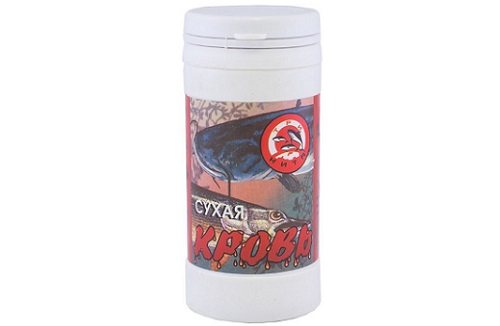
Summer bait may include dry blood
This bait is especially good in cases where the fish is lazy. For example, there are sluggish and small bites, in which the live bait is only scuffed or cut by pike teeth.
In addition, fertilizing is effective in a number of other cases. Again, on summer days, many spinning anglers are faced with the fact that pike often stands in hard-to-reach places - in bushes, near snags, algae, among water lilies, etc. At the same time, it does not respond to any bait, which, in order to avoid getting caught, has to be a couple of meters from the predator’s parking lot. Therefore, in order to lure the pike to more open areas of the reservoir, you need to use bait.
In the situation described above, it is best to lure the “toothy” one with cereals, cereals, dough, crackers, etc. Small fish will come to such food, which will attract the attention of the pike, and, most importantly, force it to come out of its hiding places. If the reservoir contains mainly only predators (this happens in many paid ponds), such luring will be of no use. It is much more effective to use the so-called glider. This is a spinning bait designed for fishing from the very surface of the water. She is not afraid of snags, water lilies and various vegetation.
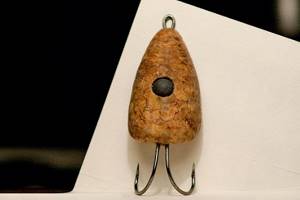
For summer fishing for pike, a glider can be used.
Pike fishing in open water
There are several ways to catch pike during the open water season. Pike can be caught with a spinning rod, with a float rod, with live bait, with a donka, with summer baits and with mugs.
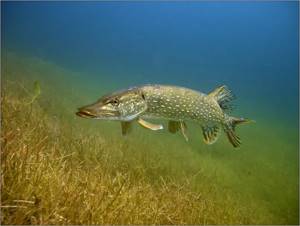
Some of these methods require the presence of a boat, others can be carried out both from a boat and from the shore. Each angler chooses for himself the method that suits him best based on the conditions in which he has to fish, the availability of certain fishing gear, and his personal preferences in fishing.
Spinning
Pike fishing with a spinning rod is the youngest, and at the same time, the most popular way of catching this predatory fish. The principle of spinning fishing is to cast the bait using a rod and then retrieve it by rotating the reel and moving the rod.
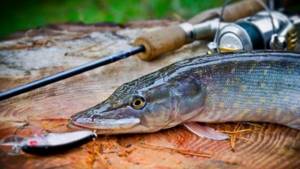
Fishing for pike with a spinning rod involves constantly moving the angler around the reservoir to search for active pike, changing baits and constantly experimenting with a variety of fishing rods. You can catch pike with a spinning rod throughout the open water season, from early spring to late autumn, with the exception of the time of spawning ban. Fishing for pike with a spinning rod can be done both from the shore and from a boat, but as a rule, a boat greatly expands the angler’s capabilities.
For pike fishing, a spinning rod is used, equipped with a spinning reel on which a cord is wound, to which an artificial bait is attached through a leash. Pike fishing with spinning rods can be done both from the shore and from a boat. To catch pike from the shore, use a rod with a length of 2.7 m, and when fishing from a boat it is easier to use a shorter rod with a length of 2.1-2.4 meters.
The diameter of the fishing line (cord) is selected taking into account the expected size of the prey. For pike fishing, both braided lines and monofilaments are used.
When fishing for pike, you must use a leash, the function of which is to protect the fishing line from the sharp teeth of the pike. The leash is most often made of Kevlar, titanium, tungsten or guitar string. Some fishermen use fluorocarbon leashes when fishing for pike; they are almost completely invisible in the water, but are less resistant to pike teeth than metal leashes.
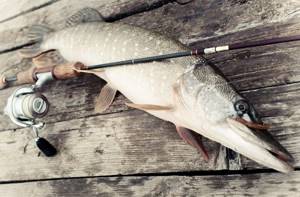
A wide variety of spinning lures are used for pike fishing:
Oscillating spinners -
one of the oldest spinning baits. They are a metal plate curved in the longitudinal or transverse direction, in the tail part of which a tee is fixed. When moving in the water, the oscillating spoon moves from side to side, rolls from side to side or trembles slightly, creating vibrations of a certain amplitude and frequency that attract predatory fish. Oscillating spoons are used for catching pike both in still water and in the current. Oscillating spoons are quite versatile, easy to use and inexpensive, which is why they are very popular among anglers.
Spinners
easy to use and catchy, most beginning spinners begin their journey in spinning by fishing with spinners. Spinner baits consist of a wire rod on which is attached a metal petal and a treble hook. When the spoon moves in the water, during the retrieve, the petal rotates around the rod, creating high-frequency vibrations and glare in the water that attract predators. Rotating spoons have numbers that indicate the size of the blade of the spoon, spoons come in sizes from 00 to 6. For catching small and medium-sized pike, rotating spoons numbered 2 and 3 are well suited; for catching large pikes, spinners numbered 4 to 6 are used.
Silicone baits
are a very popular class of lures for pike fishing. Silicone baits come in a wide variety of shapes and types, the most common among them: twisters, vibrotails, worms, octopuses, crustaceans, frogs. Many types of silicone baits resemble in their appearance real food items of predatory fish, others are completely fantasy. Silicone baits are divided into edible and inedible; attractants are added to edible baits, which additionally attract fish with their smell and taste. Silicone baits are available in a large number of different colors. For fishing, silicone baits are mounted on a jig head or on an offset hook connected to an eared sinker (Cheburashka). Lately, fishing with spaced-out rigs has become increasingly popular among spinning anglers: retractable leash, drop-shot, Carolina and Texas rigs. The method of fishing with silicone baits is called jig.
You may be interested in: Fishing in Astrakhan
Wobblers
are solid baits, their appearance resembling fry and intended for catching predatory fish. Wobblers can be of different sizes. To catch large pike, you can use wobblers with a length of 100 mm and above. For catching medium-sized pike, wobblers 7-10 cm long are suitable. Wobblers vary in shape, each of which has its own name: minnow, shad, crank, fat and others. Good results when fishing for pike are shown by minnow wobblers, which are carried out with a special jerking retrieve called twitching. Other types of wobblers show good results: shads, poppers, cranks. Wobblers vary in the degree of buoyancy; they are: floating, suspended and sinking. Wobblers also vary in depth, they can be: surface, subsurface, shallow, deep, ultra-deep. Depending on the fishing conditions, the angler selects a wobbler that is suitable in terms of its parameters and characteristics.
Live bait fishing rod
Many anglers catch pike on a float rod with live bait attached to a hook. To catch pike with a fishing rod, anglers use a long telescopic rod, which allows them to cast into windows of clear water. An inertial or spinning reel is installed on the fishing rod; most anglers use a spinning reel, which is much easier to use.
A leash must be installed between the fishing line and the hook, which can be metal, Kevlar, titanium, tungsten, guitar string or fluorocarbon fishing line. Fluorocarbon leashes are less noticeable in the water, but less resistant to pike teeth than metal leashes.

The float must be special for fishing with live bait; it is barrel-shaped and has a large carrying capacity so that the live bait cannot drown it. The float must be loaded up to the antenna. You can buy a float at a fishing store or make it yourself from a champagne cork. The float should be visible at a distance of up to 20 meters. The hooks used are relatively small; they can be triple, double or single.
When choosing live bait, you should take into account the degree of its survivability; pike prefers live and active fish; it most often ignores dead ones. Good bait for live bait: small crucian carp, carp, gudgeon, roach. It is best to catch live bait in the same body of water where fishing will take place; pike are more willing to catch food that is familiar to it. If there are a lot of frogs in the body of water where you are fishing for pike, they are most likely a frequent prey for pike, so fishing for a frog will most likely be successful. Live bait must be released into the water.
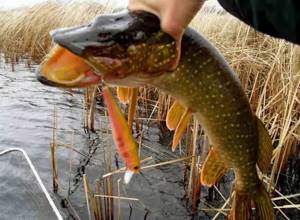
Fishing for pike with a live bait rod is most effective in the summer on small rivers with gentle currents and heavily overgrown reservoirs with standing water. It is better to catch pike with a live bait rod from a boat in order to increase the number of places fished.
After casting live bait, the fisherman waits five to seven minutes; if during this time there is no bite, he should move to another place. The fisherman can periodically return and re-fish old fishing spots that have already been fished.
Bottom fishing rod
A bottom fishing rod is not the best tackle for catching pike. In summer, pike stay in thickets of underwater vegetation, in snags. In such places there is no opportunity to perform a normal cast and to land the caught pike on the bottom tackle.
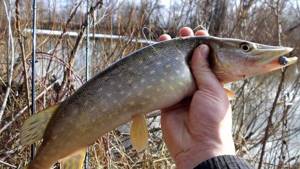
Many anglers successfully catch pike using bottom tackle in water bodies that are clear of underwater vegetation and snags. At the same time, they use both a classic donk and a donk with a rubber shock absorber. The best time for such fishing is spring, when the underwater vegetation has not yet had time to grow, and late autumn, when the bulk of the underwater vegetation has already died off. You can cast bottom gear along the shallows where pike come out to feed. You can use live bait or a frog as bait. Pike of all sizes are caught with live bait, and, as a rule, the largest individuals are caught with frogs.
If you choose between a classic donka and bottom tackle with a rubber shock absorber, then you should give preference to rubber, which does not require the use of a boat for repeated casts and creates much less noise that scares away pikes.
Catching pike with summer baits
The supply rig is the oldest equipment for catching pikes. The zherlitsa has an extremely simple device. You can fish with a zherlitsa on a pond, lake or small river. Grills are installed in places where pike often hunt for small fish: in windows among aquatic vegetation, under trees overhanging the water, next to flooded bushes.
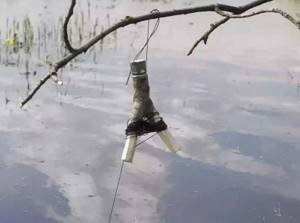
The zherlitsa consists of:
- A reel, which can be made from a wooden flyer with splits at the ends, from a plank, plywood or even a plastic bottle.
- Fishing line of sufficient strength, wound on a reel, at least 7 meters long
- A lead sinker, which is needed to hold live bait so that it does not go into the grass
- Fluorocarbon leader tied to the fishing line via a swivel
- Hook, quite large in size, which can be triple, double or single
Live bait is attached to the hook of the girder and the tackle is thrown into the water. The best live bait for catching pike in summer: bleak, dace, perch, roach, gudgeon. The fishing line is inserted into the split of the flyer in such a way that when the pike takes the bait, the fishing line is released from the split, and later, when the fishing line finishes unwinding, the pike will hook itself. The reel is tied to a tree and a pole driven on the shore or in the water.
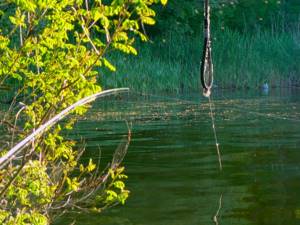
Anglers who fish with girders install several girders in the most promising places in the reservoir, and, as a rule, leave them overnight. In the morning, fishermen go around the girders one by one and check them.
Fishing with mugs
A circle is a floating version of a summer vent. The circle is a foam float in the form of a disk, which has a groove for winding fishing line at the end. Different sides of the disk are painted in different colors, usually white and red. When a pike grabs a live bait, the circle turns over with its bright side up, alerting the angler to a bite.
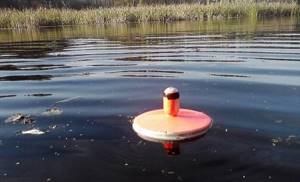
There are two ways to catch pike with mugs. The first method is used on calm rivers and lakes; mugs with attached hooks are allowed to float freely. The mugs slowly float through the water, under the influence of the current and the force of the wind, and look for the pike themselves. The second method of fishing with circles is to secure the circles in one place using a fishing line with a sinker attached to it. In this case, the mugs are placed near snags, next to thickets of grass, that is, in those places where actively feeding pike often hang out.
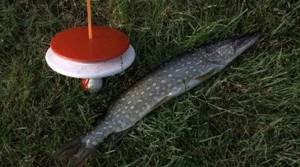
Pike fishing with mugs is done from a boat. In order to catch the maximum area of the reservoir, the mugs are installed or floated in a checkerboard pattern. The mugs must be within the angler’s visibility at all times so that he can react to pike bites.
It is best to use live bait taken from the same reservoir where pike fishing will be carried out for baiting mugs. Live bait is placed at half-water or forty centimeters from the bottom. During the fishing process, the fishing horizon is changed, depending on which horizon the bites most often occur on.
You may be interested in: Aluminum boats
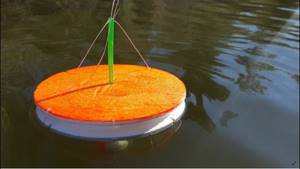
The fisherman must constantly monitor the circles and as soon as one of them is triggered, he slowly and carefully, trying not to scare off the pike that took it, swims up to the triggered circle. The fisherman carefully collects the line into the boat, and as soon as he feels the heaviness, he makes a hook and begins to fish out the caught pike. Pike are caught in circles throughout the open water season, but the best time for this method of pike fishing is September-October, the time of the autumn pike feeding season.
How to feed pike in winter
What to do at other times of the year? Let's say in winter - one of the most difficult periods for pike fishermen? At this time, it is simply necessary to use bait if the fisherman wants to go home with his catch. The fact is that in many reservoirs that are covered with ice, pike activity is reduced to a minimum. Even despite its gluttony, it feeds extremely little. What might attract her? Mostly just a school of small fish.
Therefore, with the help of special feeders, various “linen” and high-flying fish are lured. Stuff them:
- dough;
- porridge;
- cereals;
- cake;
- breadcrumbs;
- feeder mixtures and many others. etc.
All these small fish go to the fishing point because they see a nutritious and cloudy cloud emanating from the feeder. As a result, pike can also notice it. At the same time, it is unlikely that a predator will refuse to feast on various “trifles.”

In winter, feeders with bait are used for small fish, to which the pike should react
If you prefer fishing with girders, live bait or a variety of bottom baits, then pieces of fish are an excellent bait for pike in winter. For example, capelin, herring, mackerel, etc. All that is required is to chop the fish into small pieces, fill the feeders and lower them to the bottom through the holes. Such food will exude an attractive smell, which will definitely attract a toothy predator.
What is important to know about feeding pike
There are several other significant points that are important to know. They concern how exactly you need to feed the pike in order to achieve maximum results:
- Try to attract peaceful fish. Where there are roach, whitebait, topwater, small crucian carp, bleak, etc., pike will definitely come up. After all, all this is her main and favorite food.
- We recommend feeding fairly large water areas (20-30 m² or more). After all, pike hunts not only from shelters and ambushes within its visibility (at the same time, it is able to notice and feel the prey at a decent distance). Sometimes it prefers to swim around a large hole or constantly move around the perimeter of an entire backwater. Therefore, local feeding often does not produce any results.
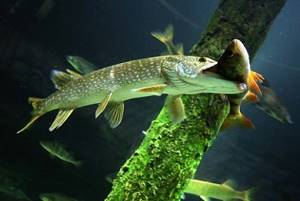
Pike reacts well to small fish, so when catching it, it is beneficial to attract small fish to the fishing spot
- Don’t be afraid to attract another predator - perch, asp, pike perch, etc. In fact, pike loves competition. She is not at all embarrassed by the presence of other “toothy ones” at the feeding site. Quite the contrary. It has been proven that pike are envious of the successes of other predators. Even if she is well-fed, but notices that within her visibility the perch is eating the same fry, then in most cases she will attack the object of its hunt.
Let's sum it up
When fishing for pike, bait plays an important, but far from decisive role. Although in many situations, including those we wrote about above, its use will provide a more effective bite. At the same time, bait should under no circumstances be considered as a “panacea for all ills”. This is just an aid. Whereas the success of pike fishing depends more on the correct choice of place, gear, bait and fishing technique than on bait.
You can learn about pike fishing in September from the video:
Fishing tactics
Fishing for pike in winter will be successful if you follow certain tactics. Of course, it depends on the chosen fishing method, but there are some general provisions:
- Detailed study of the bottom of the reservoir. The choice of fishing point depends on the winter period, so this stage should be approached very responsibly.
- Several holes are drilled and fed if desired.
- The holes are caught in order, starting with the first.
- When fishing for pike, it is useful to fish all layers at different depths.
At the end of winter, the pike begins to actively feed and often prowls in the upper layers of the water - you should not be too noisy so as not to scare away the predator
